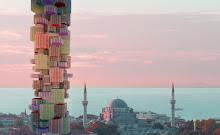For the first half of 2007, my sister worked in the prosecutor's office in the Bosnian War Crimes Chamber. During this time she was based in Sarajevo - a city she moved to with tremendous reservation and then proceeded to fall in love not only with the city but the country and its people. I have included part of an update she sent out to friends and family and some of the pictures she took during her stay in the Balkans.
But first a little historical background -
Bosnia and Herzegovina used to be held up as the model example of a functioning multi-ethnic society, where Croats, Serbs and Muslims lived completely integrated lives side-by-side. Then, as in almost all cases, the opportunistic politicians came, took advantage of hard economic times, played on fear and insecurity, and pushed the country into hell. Over three years of fighting and ethnic cleansing came to an end with the Dayton Peace Agreement in 1995, which divided the country into two entities: the Croat-Muslim Federation and Republika Srpska (the Serb entity) - essentially institutionalizing ethnic cleansing.
".... I've had an incredible time here - the work experience, the life experience ... all of it. On a daily basis, I experienced the full range of emotions - from laughter and amusement, shock and amazement to frustration and anger to sadness and sympathy, humility and gratefulness."
"Bosnia and Bosnians continue on a daily basis to fight between their past, their present and their future. The country is littered with contradictions. An outdoor rock concert with the backdrop of hundreds of grave sites. Breathtaking mountains unfrequented because of landmines. An intense love for their country, combined with desperation to leave. A desire to return to pre-war times while some still harbour residual fear of the "other." Beautifully carved pens and keychains for tourists made out of artillery from the war.
Despite having witnessed and experienced so much hate and death, Bosnians know how to love, they know how to laugh and they know how to live. I observed countless times friends and acquaintances running into one another unexpectedly on the street and within a minute, sitting down together to have a coffee. No penciling in appointments a week or two in advance. They live in the moment.
...And they have a remarkable capacity to care. I am always moved by people, who while having witnessed and experienced the worst in humanity, still manage to reflect the best in humanity. This is certainly true of the Bosnians I met."



 Yup, all that white in the picture above are tombstones that are over-flowing from the cemetery from those butchered during the war.
Yup, all that white in the picture above are tombstones that are over-flowing from the cemetery from those butchered during the war..JPG)


 The next two pictures are of Mostar. The famous Mostar Bridge was first constructed in 16th century by the Ottoman Turks. A symbol of unity between the Mostar Croats and Muslims, it was destroyed in 1993 during the war - as a powerful reminder of the disintegration of Bosnia. After the war, as part of the reconstruction efforts, the bridge, a UNESCO World Heritage Site was rebuilt in the hopes of healing old wounds and promoting co-existence and a new sense of unity (no matter how weak).
The next two pictures are of Mostar. The famous Mostar Bridge was first constructed in 16th century by the Ottoman Turks. A symbol of unity between the Mostar Croats and Muslims, it was destroyed in 1993 during the war - as a powerful reminder of the disintegration of Bosnia. After the war, as part of the reconstruction efforts, the bridge, a UNESCO World Heritage Site was rebuilt in the hopes of healing old wounds and promoting co-existence and a new sense of unity (no matter how weak).































Just a comment: the graves above are from an older cemetery across the Miljacka river, near the Vijecnica and the old town Bascarsija. These graves are old, and not what you think. The main cemetery during the war was Lion (Lav) cemetery, up near Kosevo hospital and across from the Olympic stadium, a distance from the photo you show.
ReplyDelete